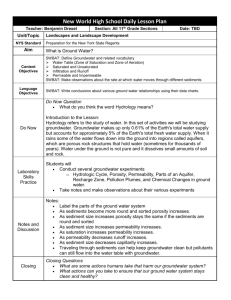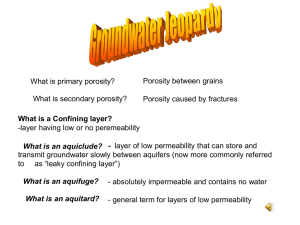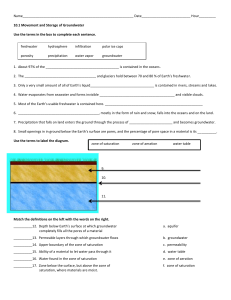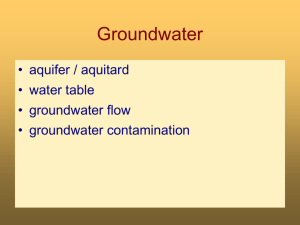Aquifers_station1_greenhill
advertisement
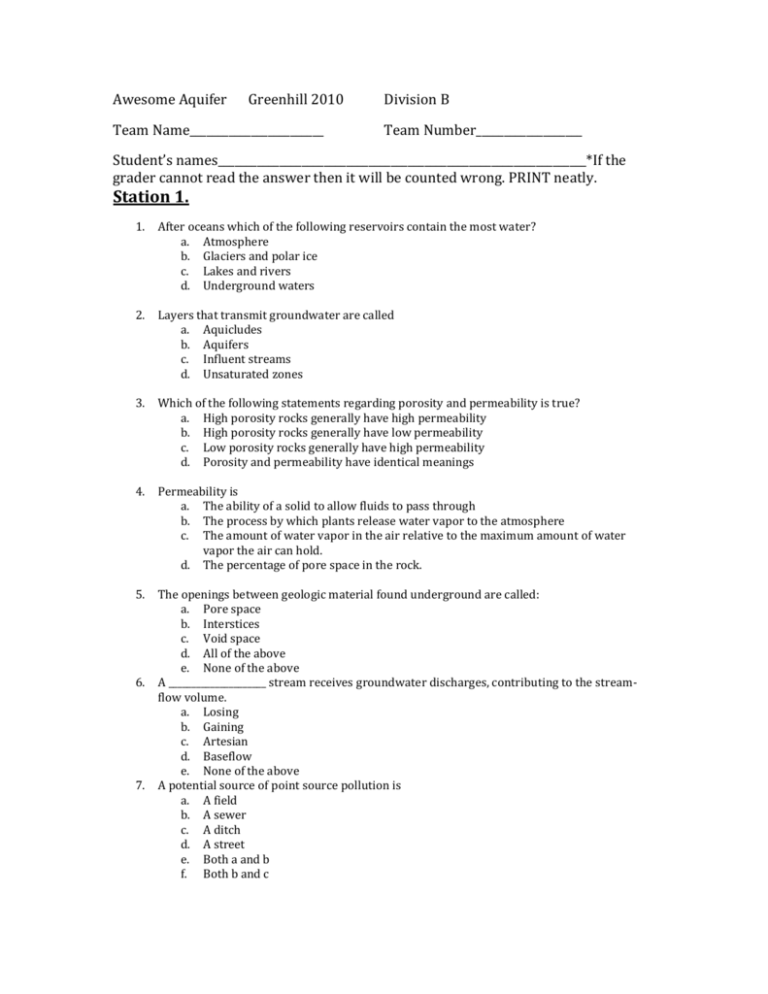
Awesome Aquifer Greenhill 2010 Team Name________________________ Division B Team Number___________________ Student’s names__________________________________________________________________*If the grader cannot read the answer then it will be counted wrong. PRINT neatly. Station 1. 1. After oceans which of the following reservoirs contain the most water? a. Atmosphere b. Glaciers and polar ice c. Lakes and rivers d. Underground waters 2. Layers that transmit groundwater are called a. Aquicludes b. Aquifers c. Influent streams d. Unsaturated zones 3. Which of the following statements regarding porosity and permeability is true? a. High porosity rocks generally have high permeability b. High porosity rocks generally have low permeability c. Low porosity rocks generally have high permeability d. Porosity and permeability have identical meanings 4. Permeability is a. The ability of a solid to allow fluids to pass through b. The process by which plants release water vapor to the atmosphere c. The amount of water vapor in the air relative to the maximum amount of water vapor the air can hold. d. The percentage of pore space in the rock. 5. The openings between geologic material found underground are called: a. Pore space b. Interstices c. Void space d. All of the above e. None of the above A _____________________ stream receives groundwater discharges, contributing to the streamflow volume. a. Losing b. Gaining c. Artesian d. Baseflow e. None of the above A potential source of point source pollution is a. A field b. A sewer c. A ditch d. A street e. Both a and b f. Both b and c 6. 7. 8. An artesian well is a well a. Tapping a unconfined aquifer b. Tapping water under pressure c. Tapping a confined aquifer d. Both a and b e. Both b and c. 9. Structural, nonstructural, and managerial techniques recognized to be the most effective and practical means to reduce groundwater contamination while still allowing the productive use of resources are called: a. Best Management practices b. Best Groundwater series c. Best Marketable practices d. Best monitoring practices. e. Best meaningful practices 10. Capillary water is a. Found in the saturated zone b. Found in the confining layer c. Just below the water table d. A term interchangeable with water table e. None of the above 11. Darcy’s law is a. A law that sets forth the conditions of groundwater contamination and the levels allowable to have safe drinking water by Harry Darcy. b. A law that is based in science formulated by Herbert Darcy in 1934 that states that groundwater should be used for private and public drinking water. c. Horace Darcy, in 1945, made a law that states that all drinking water must have floride for healthy teeth. This then decreased the decay of teeth of Americans. d. Henry Darcy formulated a groundwater movement equation in the mid 1800 based on the flow of water through beds of sand. This then formulated the basis of fluid permeability used in Earth Science. 12. The time required for a volume of groundwater to move between points is a. Erosion b. Drawdown c. Flow rate d. Discharge 13. Karst topography is defined as: a. Sandstone that makes caves, sinkholes and holes b. Irregular limestone deposits that dissolve forming sink holes, underground streams and caverns. c. Bedrock that has holes which caves, caverns, and rock formations develop. d. Land that contains holes that riddle the ground and make it hard to grow crops. 14. A process by which soluble materials in the soil such as salts, nutrients, pesticide chemicals or contaminates are washed into a lower layer of soil or are dissolved and carried away by water. a. Drawdown b. Karst c. Leaching d. Percolation 15. Water that is suitable for drinking is called: a. Nonpotable water b. Limestone water c. Potable water d. Lake water 16. A protected surface and subsurface zone surrounding a well or well field supplying a public water system to keep contaminants from reaching the well water. a. Protected groundwater area b. Swampland protection plan c. Aquifer protection site d. Wellhead protection area 17. An odorless, tasteless, colorless liquid made up of a combination of hydrogen and oxygen is called a. Liquid hydrogen b. Water c. Aquifer d. Cloud 18. Recharge occurs: a. Artificially through monitoring wells b. Where impermeable soil allows water to seep into the groundwater c. Only in confined aquifers d. All of the above e. None of the above 19. Hard water is a. Water containing high concentrations of calcium and magnesium b. Named because it tastes bad and it hard to drink c. Is very unhealthy for humans d. All of the above 20. Another name for piezometric surface is a. Zone of balance of water b. Water table c. Unsaturated zone d. Top of a well 21. In what state is every aquifer contaminated? a. New York b. New Jersey c. Texas d. Louisiana e. All of the above 22. Bioremediation of groundwater a. Uses filters and chemicals to remediate the water b. Uses microorganisms to decompose contaminants c. Uses a process of biorhythms to break up contaminants d. It is a study of biology of remediating groundwater 23. 24. 25. 26. 27. 28. 29. 30. TRUE or FALSE: Groundwater movement is determined by the amount of rain in an area. TRUE or FALSE: A spring forms wherever the water table intersects the land surface TRUE or FALSE: A sinkhole can form as limestone dissolves from the surface downward TRUE or FALSE: A perched water table is one that is dry from the sun on the land TRUE or FALSE: Groundwater flows at about 45cm per year. TRUE or FALSE: The water table is always at a constant level with the land TRUE or FALSE: Clay and shale are porous but have a low permeability. TRUE OR FALSE: Florida’s coastal groundwater is protected from saltwater intrusion.



